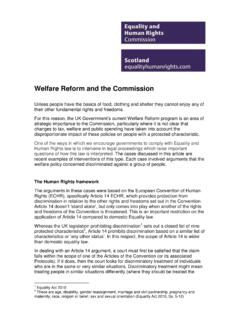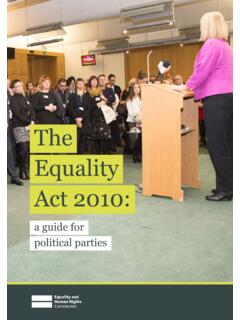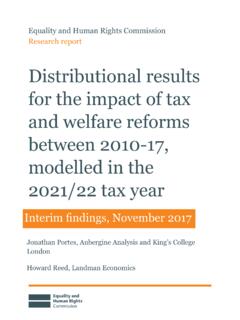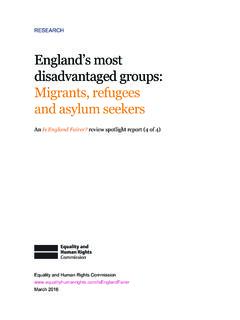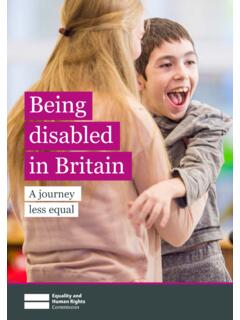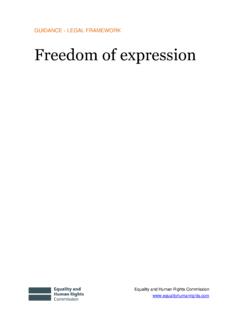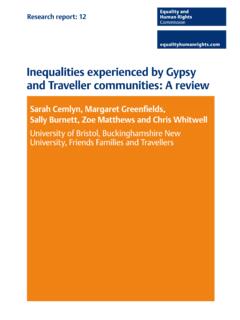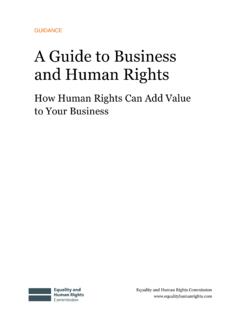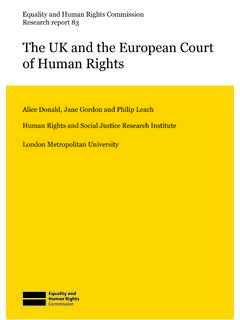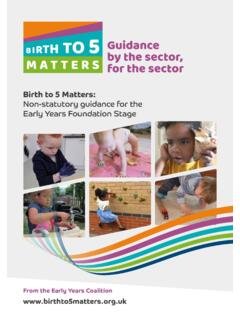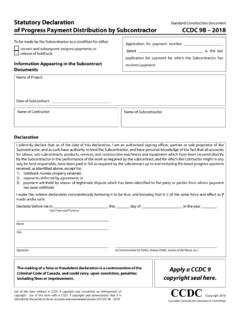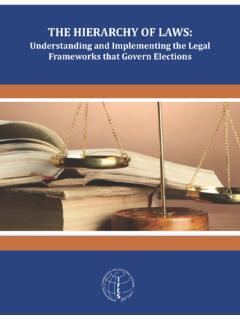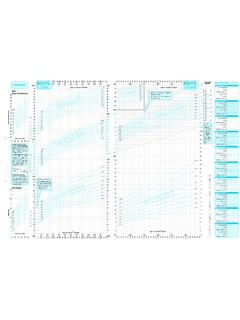Transcription of Employment Statutory Code of Practice
1 3 Equality Act 2010 code of PracticeEmployment Statutory code of Practice Equality Act 2010 code of PracticeEmployment Statutory code of Practice Equality Act 2010 Statutory code of Practice Equality and Human Rights Commission (2011) The text of this document (this excludes, where present, the Royal Arms and all departmental and agency logos) may be reproduced free of charge in any format or medium providing that it is reproduced accurately and not in a misleading context. The material must be acknowledged as Equality and Human Rights Commission copyright and the document title specified. Where third party material has been identified, permission from the respective copyright holder must be sought. Any enquiries regarding this publication should be sent to us at This publication is also available on : 9780108509735ID P002411439 01/11 Printed in the UK by The Stationery Office Limitedon behalf of the Controller of Her Majesty s Stationery Office Printed on paper containing 75% recycled fibre content Foreword 21 Chapter 1: Introduction21 Purpose of the Equality Act 201022 Scope of the code 22 Purpose of the Code23 Status of the Code23 Role of the Equality and Human Rights Commission24 Human rights24 Large and small employers25 How to use the Code26 Examples in the Code26 Use of the words employer and worker 27 References in the Code27 Changes to the law28 Further information 29 Part one: code of Practice on Employment 30 Chapter 2.
2 Protected characteristics30 Introduction30 Age30 What the Act says32 Disability32 What the Act says33 Gender reassignment 33 What the Act says35 Gender recognition certificates36 Marriage and civil partnership 36 What the Act says 36 Pregnancy and maternity 02 Contents36 What the Act says 37 Race 37 What the Act says37 Nationality 37 Ethnic origins38 National origins 38 Meaning of racial group 39 Religion or belief39 What the Act says39 Meaning of religion40 Meaning of belief41 Manifestation of religion or belief41 Sex41 What the Act says42 Sexual orientation42 What the Act says43 Restrictions on protection under the Act 44 Chapter 3: Direct discrimination 44 Introduction44 What the Act says45 What is less favourable treatment?46 Segregation47 Shared protected characteristics 47 Because of a protected characteristic49 Discrimination by association50 Discrimination by perception51 Comparators51 Who will be an appropriate comparator?
3 52 Hypothetical comparators54 Comparators in disability cases54 Comparators in sexual orientation cases55 Advertising an intention to discriminate55 Marriage and civil partnership0336 What the Act says 37 Race 37 What the Act says37 Nationality 37 Ethnic origins38 National origins 38 Meaning of racial group 39 Religion or belief39 What the Act says39 Meaning of religion40 Meaning of belief41 Manifestation of religion or belief41 Sex41 What the Act says42 Sexual orientation42 What the Act says43 Restrictions on protection under the Act 44 Chapter 3: Direct discrimination 44 Introduction44 What the Act says45 What is less favourable treatment?46 Segregation47 Shared protected characteristics 47 Because of a protected characteristic49 Discrimination by association50 Discrimination by perception51 Comparators51 Who will be an appropriate comparator?52 Hypothetical comparators54 Comparators in disability cases54 Comparators in sexual orientation cases55 Advertising an intention to discriminate55 Marriage and civil partnership56 When is it lawful to treat a person more favourably?
4 56 More favourable treatment of disabled people56 Justifiable direct discrimination because of age 58 Occupational requirements 59 Chapter 4: Indirect discrimination59 Introduction59 What the Act says 60 What constitutes a provision, criterion or Practice ?60 Is the provision, criterion or Practice a neutral one? 61 What does would put mean?61 What is a disadvantage?63 The comparative approach64 The pool for comparison 65 Making the comparison66 Carrying out a formal comparative exercise66 Is the worker concerned put at that disadvantage?67 The intention behind the provision, criterion or Practice is irrelevant67 When can a provision, criterion or Practice be objectively justified?68 What is a legitimate aim?69 What is proportionate? 71 Chapter 5: Discrimination arising from disability71 Introduction71 What the Act says71 How does it differ from direct discrimination?72 How does it differ from indirect discrimination?
5 72 Is a comparator required?73 What is unfavourable treatment ?73 What does something arising in consequence of disability mean?04 Contents74 When can discrimination arising from disability be justified?74 What if the employer does not know that the person is disabled?76 When can an employer be assumed to know about disability?77 Relevance of reasonable adjustments 78 Chapter 6: Duty to make reasonable adjustments78 Introduction78 What the Act says79 What is the duty to make reasonable adjustments?79 Accessible information79 Avoiding substantial disadvantages caused by physical features80 Which disabled people does the duty protect?80 What is a provision, criterion or Practice ?80 What is a physical feature ?81 What is an auxiliary aid ?81 What disadvantage gives rise to the duty?82 What if the employer does not know that a disabled person is an actual or potential job applicant?
6 82 What if the employer does not know the worker is disabled?83 When can an employer be assumed to know about disability?84 What is meant by reasonable steps ?85 Can failure to make a reasonable adjustment ever be justified?85 What happens if the duty is not complied with?0574 When can discrimination arising from disability be justified?74 What if the employer does not know that the person is disabled?76 When can an employer be assumed to know about disability?77 Relevance of reasonable adjustments 78 Chapter 6: Duty to make reasonable adjustments78 Introduction78 What the Act says79 What is the duty to make reasonable adjustments?79 Accessible information79 Avoiding substantial disadvantages caused by physical features80 Which disabled people does the duty protect?80 What is a provision, criterion or Practice ?80 What is a physical feature ?81 What is an auxiliary aid ?81 What disadvantage gives rise to the duty?
7 82 What if the employer does not know that a disabled person is an actual or potential job applicant?82 What if the employer does not know the worker is disabled?83 When can an employer be assumed to know about disability?84 What is meant by reasonable steps ?85 Can failure to make a reasonable adjustment ever be justified?85 What happens if the duty is not complied with?86 Reasonable adjustments in practice86 Making adjustments to premises86 Providing information in accessible formats86 Allocating some of the disabled person s duties to another worker87 Transferring the disabled worker to fill an existing vacancy87 Altering the disabled worker s hours of work or training87 Assigning the disabled worker to a different place of work or training or arranging home working87 Allowing the disabled worker to be absent during working or training hours for rehabilitation, assessment or treatment88 Giving, or arranging for, training or mentoring (whether for the disabled person or any other worker)
8 88 Acquiring or modifying equipment88 Modifying procedures for testing or assessment88 Providing a reader or interpreter89 Providing supervision or other support89 Allowing a disabled worker to take a period of disability leave89 Participating in supported Employment schemes, such as Workstep89 Employing a support worker to assist a disabled worker89 Modifying disciplinary or grievance procedures for a disabled worker90 Adjusting redundancy selection criteria for a disabled worker90 Modifying performance-related pay arrangements for a disabled worker91 The Access to Work scheme 06 Contents92 Chapter 7: Harassment92 Introduction92 What the Act says93 Harassment related to a protected characteristic94 Related to 96 Sexual harassment96 Less favourable treatment for rejecting or submitting to unwanted conduct97 Purpose or effect 98 Liability of employers for harassment by third parties 99 Chapter 8: Pregnancy and maternity99 Introduction99 What the Act says100 The protected period101 Unfavourable treatment outside the protected period102 Pregnancy of hers 102 Knowledge of pregnancy102 No need for comparison103 Not the only reason103 Unfavourable treatment104 Other Employment rights for pregnant women105 Health and safety at work106 Pay and conditions during maternity leave107 Non-contractual payments during maternity leave108 Special treatment in connection with pregnancy and childbirth is lawful108 Breastfeeding0792 Chapter 7.
9 Harassment92 Introduction92 What the Act says93 Harassment related to a protected characteristic94 Related to 96 Sexual harassment96 Less favourable treatment for rejecting or submitting to unwanted conduct97 Purpose or effect 98 Liability of employers for harassment by third parties 99 Chapter 8: Pregnancy and maternity99 Introduction99 What the Act says100 The protected period101 Unfavourable treatment outside the protected period102 Pregnancy of hers 102 Knowledge of pregnancy102 No need for comparison103 Not the only reason103 Unfavourable treatment104 Other Employment rights for pregnant women105 Health and safety at work106 Pay and conditions during maternity leave107 Non-contractual payments during maternity leave108 Special treatment in connection with pregnancy and childbirth is lawful108 Breastfeeding110 Chapter 9: Victimisation and other unlawful acts110 Introduction110 Victimisation110 What the Act says111 What is a protected act ?
10 112 What is a detriment ?112 What other factors are involved in proving that victimisation has occurred?113 Instructing, causing or inducing discrimination113 What the Act says115 When does the Act apply?115 Who is protected?116 Aiding contraventions116 What the Act says116 What does it mean to help someone commit an unlawful act?117 What does the helper need to know to be liable?117 Reasonable reliance on another s statement118 Gender reassignment discrimination - absence from work118 What the Act says 119 Chapter 10: Obligations and liabilities under the Act119 Introduction119 Definition of employment120 Obligations of employers to job applicants and employees121 What the Act says about employers obligations to job applicants121 What are arrangements?121 What are terms on which Employment is offered? 08 Contents122 What the Act says about employers obligations to employees122 Terms of employment122 Dismissals123 Discrimination and unfair dismissal123 Detriment124 Employers duty to make reasonable adjustments124 Harassment of job applicants and employees125 Harassment by third parties126 Pre- Employment enquiries about disability and health127 Exceptions to the general rule prohibiting disability or health-related questions127 Reasonable adjustment needed for the recruitment process128 Monitoring purposes128 Implementing positive action measures128 Occupational requirements129 National security129 Function intrinsic to the job130 Disability and health enquiries after a job offer132 Armed forces 132 Liability of employers and principals under the Act132 Employers133 Principals133 How employers and principals can avoid liability134 Employers and principals liability for other unlawful acts135 Liability
